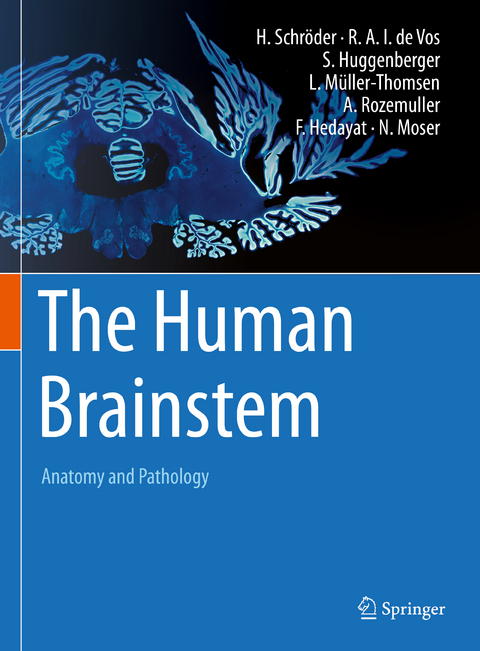
The Human Brainstem
Springer International Publishing (Verlag)
978-3-030-89979-0 (ISBN)
The human brainstem has long been a neglected area in clinical medicine. This is shown by the fact that there is no introductory book on the neuroanatomy and pathology of this region.
This book is intended to introduce the reader to the neuroanatomy of the human brainstem and combines an atlas with detailed information on the individual structures. The atlas features a state-of-the-art magnetic resonance imaging series, histological specimens (Darrow Red and Campbell staining) and a plastinate-based topographical part, which allows direct comparison of histological and topographical findings with neuroimaging. In addition, the reader is guided along the brainstem neuromer model through the human brainstem and learns about the functional properties of the individual structures of the brainstem. Where appropriate, peripheral targets of brainstem structures are illustrated and explained. Furthermore, each chapter covers the most important neurological disorders affecting the brainstem.
This book aims to demonstrate that sound anatomical knowledge is required to understand brainstem pathology. It will particularly help those new to the field to better understand the complex anatomy of the human brainstem and will be useful to basic and clinical neuroscientists alike.
lt;p>Hannsjörg Schröder MD
was professor at the Department II of Anatomy of the University of Köln, Germany, from 1992 - 2019. His teaching focused on the clinical neuroanatomy of humans and the comparative neuroanatomy of rodentia for students of medicine and neuroscience. He founded the BSc / MSc program Neuroscience in 2003. His research focuses on topics of neurodegeneration in man and mouse models using molecular histochemical models.
Rob A. I. de Vos MD
worked for many years as clinical pathologist and neuropathologist in the Laboratorium Pathologie OostNederland (LabPON) Twente in Enschede (now in Hengelo), one of the largest pathology inititutes of the Netherlands. His main scientific interest are neurodegenerative diseases, with Parkinsonism and related disorders, dementias and spinocerebellar ataxias as main topics.
Stefan Huggenberger PhD
is zoologist and lecturer at the Institute of Anatomy and Clinical Morphology at the University of Witten/Herdecke, Germany. His research deals with the comparative anatomy of the senses of vertebrates, especially of whales and dolphins. His expertise is reflected in numerous scientific publications and several reference books.
Lennart Müller-Thomsen PhD
is biologist and lecturer at the Institute of Anatomy and Clinical Morphology at the University of Witten/Herdecke, Germany. His research deals with neurodegenerative diseases of the brain. The focus of interest are the electrophysiological and morphological neuronal changes due to hyperphosphorylated tau protein and pretangles in tauopathies.
Annemieke Rozemuller MD
is professor of neuropathology in Amsterdam UMC with extensive expertise in neurodegeneration. As neuropathologist for the Netherlands Brain bank and for the prion lab in UMC Utrecht she does the diagnostics of both rapidly progressive and slowly progressive dementias, movement disorders and psychiatric disorders.
Farman Hedayat MD
is a senior consultant in neurosurgery and a certified spine surgeon. He wrote his dissertation at the Department II for Anatomy in Cologne, Germany, on the Distribution of Opioid Receptors in the Human Brainstem. He has been working during his medical education as a tutor in Anatomy and Neuroanatomy courses for many years.
Natasha Moser Dr. rer. medic.
is a graduate biologist and a former lecturer at the Department II of Anatomy at the University of Köln, Germany. She has been teaching macroscopic anatomy and neuroanatomy courses for many years for human and dental medicine students. Since 2008 she teaches neuroanatomy to prospective physiotherapists and since recently to prospective orthoptists. Her scientific interest focuses on neurodegeneration (Alzheimer's disease, Parkinson's disease) and nicotine receptors.
PART I.- General consideration.- Development of the brainstem.- Rhombomere 11 r11.- Rhombomere 10 r10.- Rhombomere 9 r9.- Rhombomere 8 r8.- Rhombomere 7 r7.- Rhombomere 6 r6.- Rhombomere 5 r5.- Rhombomere 4 r4.- Rhombomere 3 r3.- Rhombomere 2 r2.- Rhombomere 1 r1.- Isthmus r0.- Mesencephalon m1 /m2.- Pretectum p1 (Prosomere 1).- PART II ATLAS.- Histology atlas of the human brain.- Darrow red series (Visualization of perikarya).- Campbell series (Visualization of fiber tracts).- Atlas of the human brainstem - magnetic resonance imaging (MRI).- Topographical atlas of plastinated sections of the human brainstem and cranial nerve target structures.
| Erscheinungsdatum | 10.08.2023 |
|---|---|
| Zusatzinfo | XX, 697 p. 831 illus., 786 illus. in color. |
| Verlagsort | Cham |
| Sprache | englisch |
| Maße | 210 x 279 mm |
| Gewicht | 1979 g |
| Themenwelt | Studium ► 1. Studienabschnitt (Vorklinik) ► Anatomie / Neuroanatomie |
| Naturwissenschaften ► Biologie ► Humanbiologie | |
| Schlagworte | Disorders of the human brain stem • Human cranial nerves • Human IVth ventricle and mesencephalic aqueduct • Medulla oblongata • Mesencephalon • MRT • Pons • Reticular formation • Tract systems of the human brain stem |
| ISBN-10 | 3-030-89979-9 / 3030899799 |
| ISBN-13 | 978-3-030-89979-0 / 9783030899790 |
| Zustand | Neuware |
| Informationen gemäß Produktsicherheitsverordnung (GPSR) | |
| Haben Sie eine Frage zum Produkt? |
aus dem Bereich


